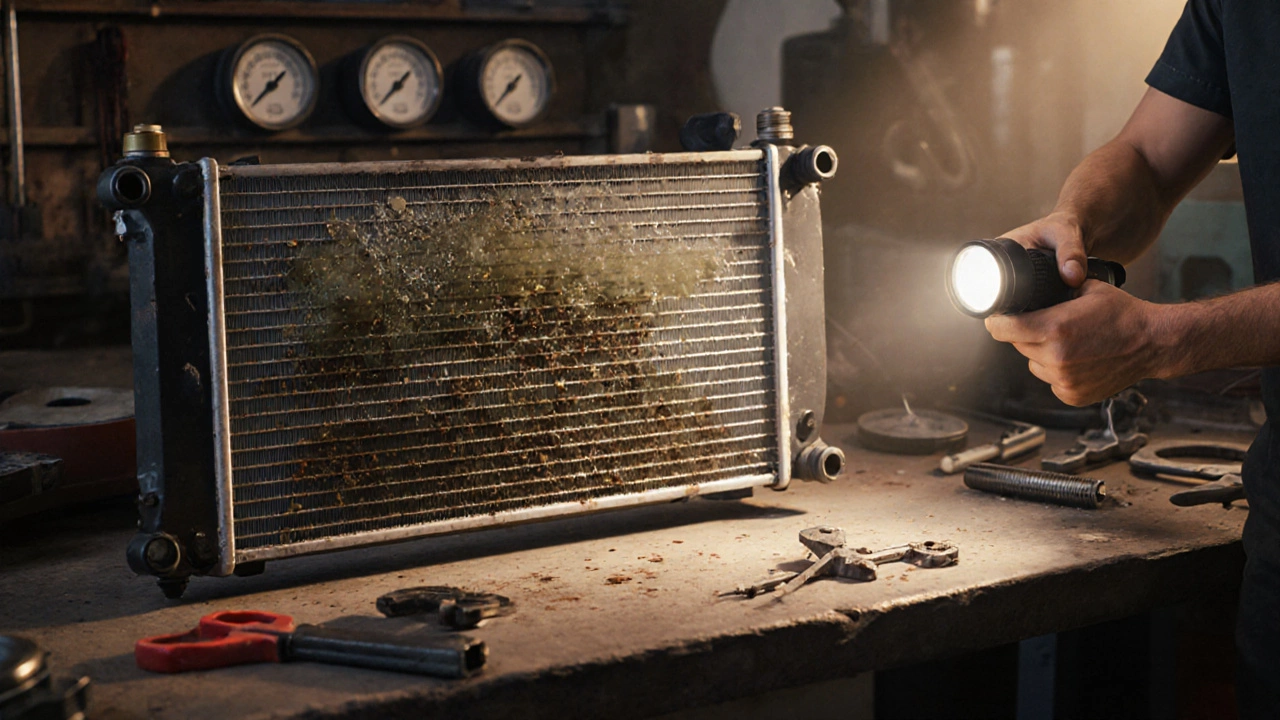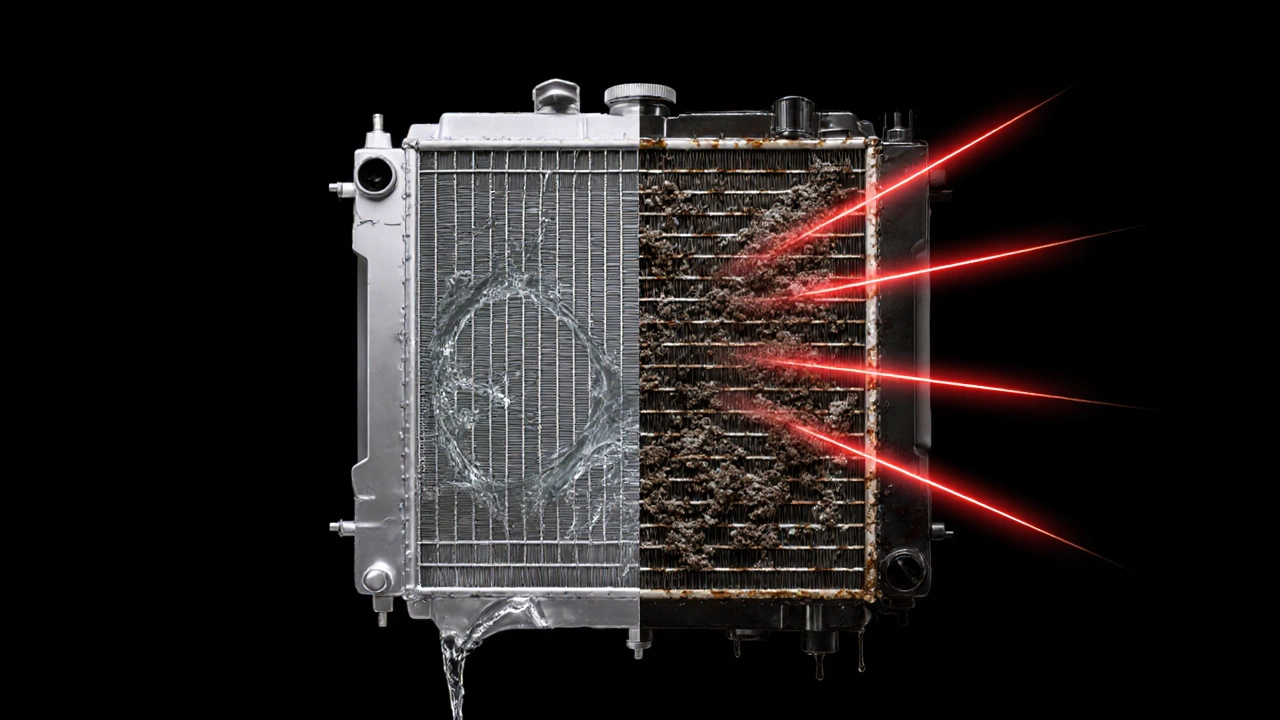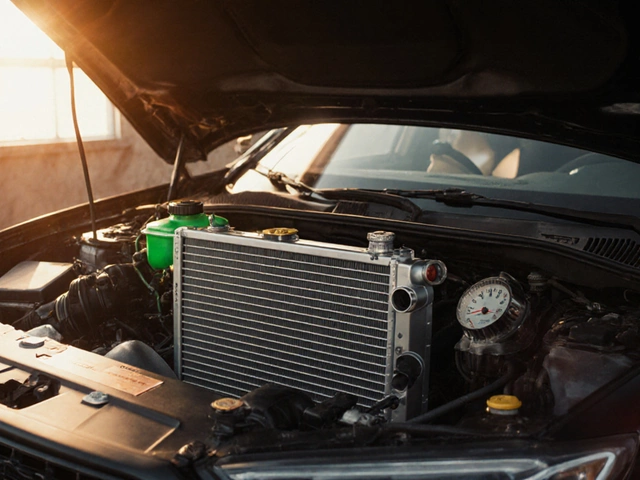Radiator Lifespan Estimator
How Long Will Your Radiator Last?
Estimate when your radiator might need replacement based on your vehicle's condition and maintenance history.
Enter your vehicle details and click "Calculate" to see your radiator's estimated remaining lifespan.
Most people don’t think about their radiator until it starts leaking steam or the temperature gauge spikes. But that’s when you realize how critical it is. A radiator isn’t just a metal box under the hood-it’s the heart of your engine’s cooling system. And like any part that works nonstop under pressure, it wears out. So how long does a radiator actually last?
Typical Lifespan of a Car Radiator
On average, a car radiator lasts between 8 and 12 years or about 100,000 to 150,000 miles. That’s the sweet spot for most factory-installed radiators made from aluminum and plastic end tanks. But this number isn’t set in stone. Some radiators fail at 60,000 miles. Others last past 200,000. What makes the difference? It’s not luck. It’s maintenance, driving habits, and environment.
Older cars with copper-brass radiators could last 20 years or more. But modern radiators use lighter materials to save weight and improve fuel efficiency. That trade-off means they’re more prone to corrosion and cracking over time. If your car is 10 years old and you’ve never flushed the coolant, you’re already on borrowed time.
What Kills a Radiator?
It’s not just age. It’s what’s inside the system. Coolant isn’t just water-it’s a mix of antifreeze and additives that prevent rust, scale, and overheating. When those additives break down, the coolant turns acidic. That acid eats away at the metal, especially at the seams where the aluminum core meets the plastic tanks.
Here’s what actually kills radiators:
- Dirty or old coolant - After 5 years or 50,000 miles, coolant loses its protective properties. If you don’t flush it, corrosion starts eating the inside of the radiator from the bottom up.
- Overheating - One severe overheating event can warp the core or crack a tank. Even if the engine seems fine after, internal damage may be hidden.
- Physical damage - Road debris, rocks, or even a bad parking job can dent or puncture the radiator. A small crack can turn into a major leak in weeks.
- Improper installation - If a radiator isn’t seated right or hoses are pinched, pressure builds where it shouldn’t. That leads to leaks or bursts.
- Hard water - Using tap water instead of distilled water in a coolant mix leaves mineral deposits that clog narrow coolant passages.
One mechanic I worked with said it best: “A radiator doesn’t die from age. It dies from neglect.”
Signs Your Radiator Is Failing
You don’t need a diagnostic tool to spot a bad radiator. Here are the real-world signs:
- Constant low coolant levels - If you’re topping off coolant every few weeks, there’s a leak. Check under the car for green, orange, or pink puddles.
- Sludge or rust in the coolant - Pop the radiator cap (when cold!) and look inside. If the fluid looks muddy or has flakes floating in it, corrosion is already inside.
- Overheating at idle or low speeds - A radiator that works fine on the highway but fails in traffic usually has a clogged core or failing fan clutch.
- Steam or sweet smell from the hood - That’s coolant boiling off. Don’t ignore it. Keep driving and you’ll warp the cylinder head.
- Visible cracks or bulges - Look at the plastic end tanks. If they’re swollen or have hairline cracks, the radiator is done.
Some people wait until the car won’t start. That’s too late. By then, the engine might already be damaged. A radiator failure can cost $1,500 to fix if it takes out the head gasket. Replacing the radiator? $300-$600.

How to Make Your Radiator Last Longer
You don’t have to replace your radiator every 10 years. You can stretch it to 15 or even 20 if you treat it right.
- Flush coolant every 50,000 miles or 5 years - Even if the bottle says “100,000-mile life,” that’s under perfect conditions. Most drivers don’t get that. Use the coolant type your manual recommends.
- Use distilled water, not tap water - Tap water has minerals that build up and block flow. Distilled water is clean and safe.
- Check for leaks regularly - Look under the car after parking. Check hoses for softness or cracks. A loose clamp can cause slow leaks that turn into big problems.
- Don’t ignore overheating - If the temperature needle goes into the red, pull over immediately. Let the engine cool. Don’t open the cap. Call a tow.
- Keep the front grille clean - Leaves, bugs, and dirt block airflow. Clean it with a hose every few months, especially in summer or dusty areas.
These aren’t luxury steps. They’re basic care. Like changing your oil. Skip them, and you’re gambling with your engine.
Replacement Options: OEM, Aftermarket, or Upgraded?
When it’s time to replace, you have choices:
| Type | Material | Price Range | Lifespan | Best For |
|---|---|---|---|---|
| OEM (Original Equipment) | Aluminum + plastic | $400-$700 | 8-12 years | Stock vehicles, warranty coverage |
| Aftermarket (standard) | Aluminum + plastic | $200-$400 | 5-10 years | Budget repairs, older cars |
| Upgraded (copper-brass) | Copper core + brass tanks | $500-$900 | 15-20+ years | Classic cars, high-performance, hot climates |
OEM parts are exact copies of what came with your car. They fit perfectly but cost the most. Aftermarket parts are cheaper and often just as good-if you pick a reputable brand like Denso, Spectra, or Koyo. Avoid the cheapest no-name brands. They use thinner metal and weaker seals.
Upgraded copper-brass radiators are heavier and harder to find, but they’re far more durable. They’re common in classic cars or trucks used in extreme heat. For a daily driver? Stick with aluminum. It’s lighter, cheaper, and good enough if maintained.

When to Replace vs. Repair
Can you fix a radiator instead of replacing it? Sometimes. But rarely worth it.
Small leaks at the seams? A professional can sometimes solder them. But aluminum radiators are hard to weld without damaging the core. Plastic tanks? You can’t fix cracked plastic. It’ll leak again in weeks.
One common myth: “I’ll just add stop-leak.” Don’t. Stop-leak products clog the narrow coolant passages in the radiator and heater core. They might stop a drip for a few weeks, but they’ll cause overheating later. It’s a band-aid that kills the system.
If your radiator is over 8 years old and showing signs of failure, replacement is the only smart choice. The labor cost is the same whether you fix or replace. Why risk another failure in six months?
What Happens If You Ignore a Bad Radiator?
Ignoring a failing radiator doesn’t just mean a hot engine. It means expensive, avoidable damage:
- Head gasket failure - Overheating warps the cylinder head. Coolant leaks into the combustion chamber. Repair: $1,500-$3,000.
- Engine seizure - If the engine runs too hot for too long, pistons can expand and stick. Total engine rebuild or replacement: $4,000-$8,000.
- Warped cylinder head - Even if the engine doesn’t seize, the head may need resurfacing or replacement.
- Heater core damage - The same coolant that cools the engine also heats your cabin. A clogged or leaking radiator often means the heater core is next.
Replacing a radiator is cheap compared to fixing the engine it protects.
Final Takeaway
Your radiator isn’t a “set it and forget it” part. It’s a critical component that needs attention. If your car is 8+ years old, check the coolant condition. Look for leaks. Listen for strange noises. Don’t wait for steam to come out of the hood.
Flush the coolant every 5 years. Use the right fluid. Clean the grille. And if you see any warning signs-replace it. A $400 radiator is nothing compared to a $5,000 engine rebuild.
Think of it like tires. You don’t wait until they blow out to replace them. Same rule applies here.
How long does a radiator last on average?
Most car radiators last between 8 and 12 years, or about 100,000 to 150,000 miles. This depends heavily on coolant maintenance, driving conditions, and whether the system has been flushed regularly. Older copper-brass radiators can last longer, but modern aluminum radiators are more common and require consistent care.
Can a radiator be repaired instead of replaced?
Small leaks in metal sections can sometimes be repaired with professional welding, but it’s rarely cost-effective. Plastic end tanks cannot be repaired if cracked. Stop-leak products are not a real fix-they clog coolant passages and often cause more damage. If the radiator is over 8 years old or shows signs of corrosion, replacement is the only reliable option.
What causes a radiator to fail prematurely?
The top causes are dirty or old coolant, overheating events, physical damage from road debris, improper installation, and using tap water instead of distilled water in the coolant mix. Corrosion from acidic coolant is the #1 silent killer of modern radiators.
Should I use OEM or aftermarket radiators?
OEM radiators are exact replacements and fit perfectly but cost more. Reputable aftermarket brands like Denso, Spectra, and Koyo offer reliable performance at lower prices. Avoid no-name brands-they often use thinner materials and weaker seals. For most daily drivers, a good aftermarket radiator is the best balance of cost and durability.
How often should I flush my radiator coolant?
Flush the coolant every 50,000 miles or every 5 years, whichever comes first. Even if the coolant bottle says “100,000-mile life,” real-world conditions like heat, stop-and-go driving, and contamination reduce its effectiveness. Flushing removes rust, scale, and acidic buildup that can destroy the radiator over time.
Can a bad radiator cause my engine to overheat?
Yes, absolutely. A clogged, leaking, or damaged radiator can’t remove heat from the engine properly. This leads to overheating, especially at low speeds or in traffic. Overheating can warp the cylinder head, blow the head gasket, or even seize the engine. Never ignore signs of radiator trouble.
What’s the difference between aluminum and copper-brass radiators?
Aluminum radiators are lighter, cheaper, and common in modern cars. They’re efficient but more prone to corrosion from dirty coolant. Copper-brass radiators are heavier and more durable, often used in classic cars or high-heat environments. They last longer but are harder to find and more expensive to replace. For most drivers, aluminum is fine-if maintained properly.


